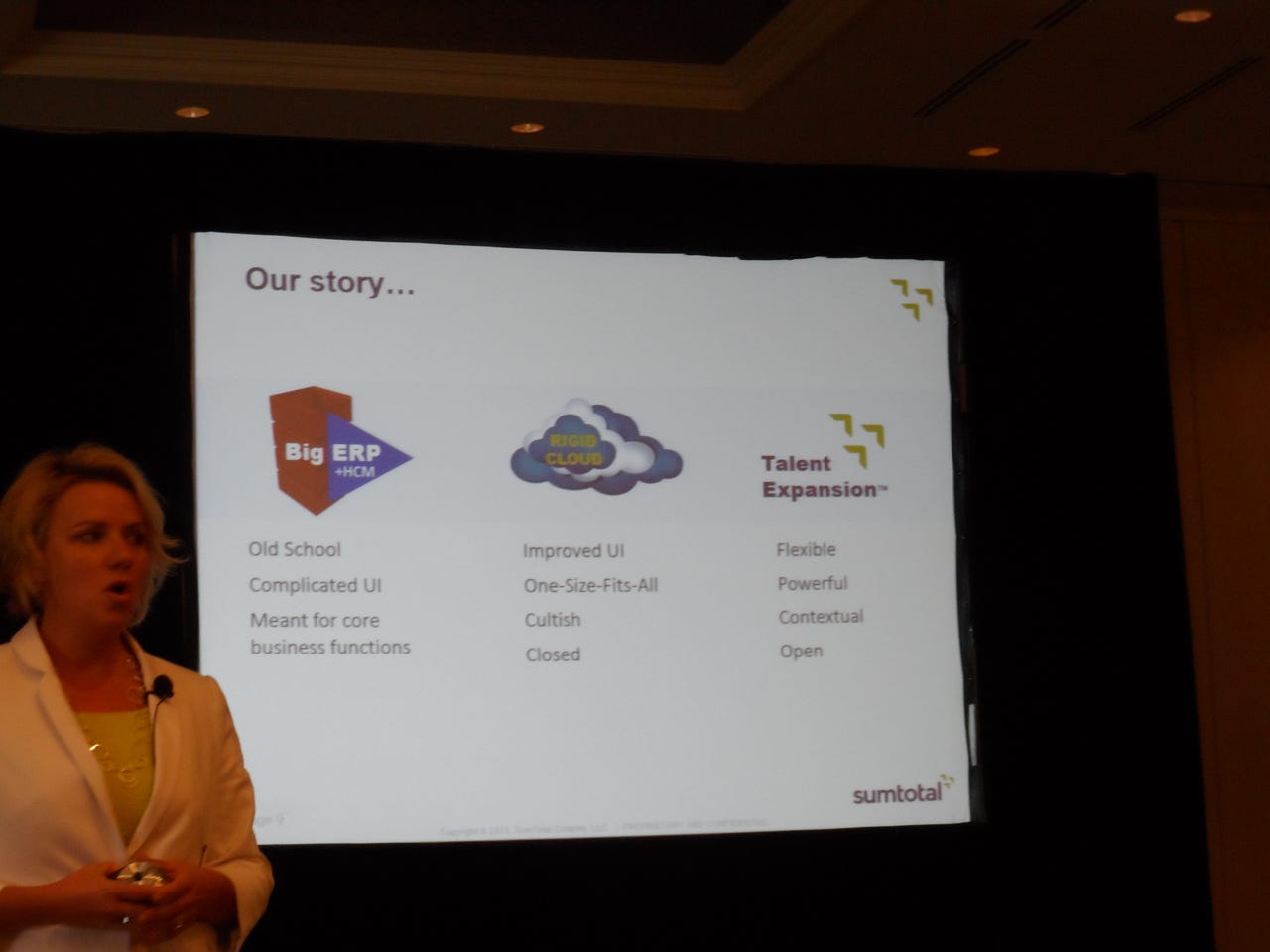How to succeed in HR software

Ever wonder how some software companies come up with their go-to-marketing and sales strategies? I heard some interesting things and saw some cool stuff lately that shed some light on the process.
At a recent SumTotal Analyst Summit, John Borgerding, SumTotal CEO, said that they have “the most comprehensive, unified suite” in the Human Capital (HC) space. But earlier that day Holly Rollo, SumTotal CMO, said something that sounded contradictory. She said that they “Don’t want to be another suite vendor”. Later that day, I came to understand the two different points.

SumTotal understands that if it tries to sells a prospect their full HC suite, buyers might object to needing to rip & replace several incumbent solutions. In that scenario, deals can quickly come undone as the integration cost, business disruption, training effort, implementation challenges, total initial costs, etc. are too big for the buyer. So, to mitigate these objections, SumTotal sells only what the customer needs in that moment and makes their products very easy to install and integrate. When the customer wants to expand their SumTotal footprint, SumTotal will likely have the missing applications and the customer should be favorably inclined to acquire more of these easy to install/integrate solutions.
In contrast, Workday is definitely selling their entire suite. They want to encourage rip and replace activity within the Fortune 500. I sense they’d like nothing more to displace a lot of SAP, Oracle, Infor or other ERP suites with their products. Workday can do this as they are clearly not stopping at the solution boundaries of HC (human capital). They’ve introduced Financial and Analytics capabilities with an eye to more products in later years.
Small, one-application software companies know they lack a suite. They can’t sell a suite directly or at a later day. They win by creating truly different, bleeding edge solutions that firms believe must be bought now if their company is retain some semblance of competitive parity (or if they’re lucky, competitive advantage). For these firms, it’s all about the amazing functions and features. In the HC space, some really innovative, different firms that are re-defining the HC Sourcing space would include: Entelo, TalentBin and BullHorn Reach. One could also make the case that LinkedIn fits in here, too.
So, if you notice, killer functions and features start off as key differentiators when a vendor is usually really small and fighting for any market acceptance. Once they’ve created something resembling the beginnings of a suite, functions and features take second place behind capabilities like integration and fast/cheap implementations. For proof, just look at how many cloud application software vendors have succeeded by constantly touting the ease with which their solutions can be integrated with cloud and on-premises solutions.
By the time a vendor has a full ERP suite, functions and features are a distant third place. The suite’s breadth and depth (e.g., vertical solution variants) is the number one sales determinant. Integration/implementation matters or global coverage are secondary concerns.
So, SumTotal’s positioning is spot on.
To further test this hypothesis, I quizzed Chris Leone, SVP Oracle Applications Development (HCM), while at their recent Oracle Open World. Chris listed off a litany of HCM applications that are part of their HCM Cloud Services Suite. He then added that he “believes it is more important for customers to standardize on a suite than a bunch of best of breed products”. He’s right in that customers generally prefer the pre-integrated nature of suites over getting stuck with a bunch of never-ending integration and interface work.
But, buyers need to be careful as not all suites, especially cloud suites, are in fact the integration dream come true one hopes them to be. There’s been a lot of merger and acquisition activity in the cloud space and at times the HCM sector has been leading the race. Just because two applications can now connect with one another doesn’t mean that there is one data model, one source of truth, etc.. You might still find differences in data meanings, latency issues (as data moves from one system to another), problems with rolling out enhancements to one application but not another, etc.
Workday’s suite is clearly one of the tightest suites in that virtually everything they have was internally developed. Yes, developing all your own applications takes more time than buying pre-existing solutions/firms but patient customers will likely enjoy the end result. Workday only made one acquisition and that was an enterprise service bus for their technical architecture around 2005. I have a greater degree of confidence that their suites are genuinely integrated and should result in fewer long-term cost, upgrade, usage and integration issues for their customers.
In watching the software space for decades, I would conclude that customers will often buy large parts of ever larger growing suites when it makes business sense to do so. I also believe that companies cannot avoid buying a number of best of breed solutions as many of these products are simply too new, too innovative, etc. that the larger suite players haven’t created competitive solutions for these yet.
Disclosure: Workday and SumTotal covered travel and lodging to their analyst events.